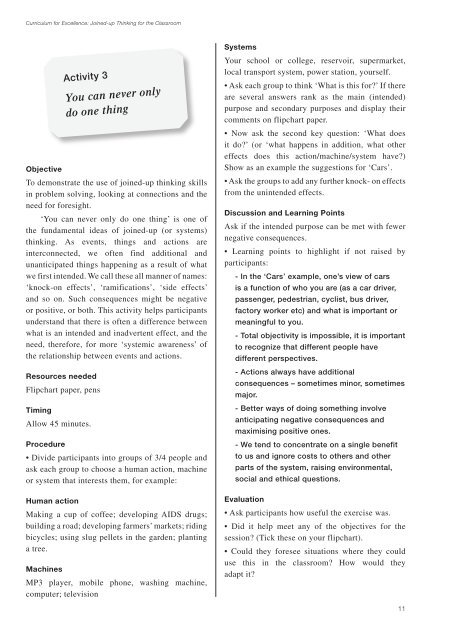Curriculum for Excellence: Joined-up Thinking for the ... - WWF UK
Curriculum for Excellence: Joined-up Thinking for the ... - WWF UK
Curriculum for Excellence: Joined-up Thinking for the ... - WWF UK
- No tags were found...
You also want an ePaper? Increase the reach of your titles
YUMPU automatically turns print PDFs into web optimized ePapers that Google loves.
<strong>Curriculum</strong> <strong>for</strong> <strong>Excellence</strong>: <strong>Joined</strong>-<strong>up</strong> <strong>Thinking</strong> <strong>for</strong> <strong>the</strong> ClassroomObjectiveTo demonstrate <strong>the</strong> use of joined-<strong>up</strong> thinking skillsin problem solving, looking at connections and <strong>the</strong>need <strong>for</strong> <strong>for</strong>esight.‘You can never only do one thing’ is one of<strong>the</strong> fundamental ideas of joined-<strong>up</strong> (or systems)thinking. As events, things and actions areinterconnected, we often find additional andunanticipated things happening as a result of whatwe first intended. We call <strong>the</strong>se all manner of names:‘knock-on effects’, ‘ramifications’, ‘side effects’and so on. Such consequences might be negativeor positive, or both. This activity helps participantsunderstand that <strong>the</strong>re is often a difference betweenwhat is an intended and inadvertent effect, and <strong>the</strong>need, <strong>the</strong>re<strong>for</strong>e, <strong>for</strong> more ‘systemic awareness’ of<strong>the</strong> relationship between events and actions.Resources neededFlipchart paper, pensTimingAllow 45 minutes.Procedure• Divide participants into gro<strong>up</strong>s of 3/4 people andask each gro<strong>up</strong> to choose a human action, machineor system that interests <strong>the</strong>m, <strong>for</strong> example:Human actionMaking a c<strong>up</strong> of coffee; developing AIDS drugs;building a road; developing farmers’ markets; ridingbicycles; using slug pellets in <strong>the</strong> garden; plantinga tree.MachinesActivity 3You can never onlydo one thingMP3 player, mobile phone, washing machine,computer; televisionSystemsYour school or college, reservoir, s<strong>up</strong>ermarket,local transport system, power station, yourself.• Ask each gro<strong>up</strong> to think ‘What is this <strong>for</strong>?’ If <strong>the</strong>reare several answers rank as <strong>the</strong> main (intended)purpose and secondary purposes and display <strong>the</strong>ircomments on flipchart paper.• Now ask <strong>the</strong> second key question: ‘What doesit do?’ (or ‘what happens in addition, what o<strong>the</strong>reffects does this action/machine/system have?)Show as an example <strong>the</strong> suggestions <strong>for</strong> ‘Cars’.• Ask <strong>the</strong> gro<strong>up</strong>s to add any fur<strong>the</strong>r knock- on effectsfrom <strong>the</strong> unintended effects.Discussion and Learning PointsAsk if <strong>the</strong> intended purpose can be met with fewernegative consequences.• Learning points to highlight if not raised byparticipants:- In <strong>the</strong> ‘Cars’ example, one’s view of carsis a function of who you are (as a car driver,passenger, pedestrian, cyclist, bus driver,factory worker etc) and what is important ormeaningful to you.- Total objectivity is impossible, it is importantto recognize that different people havedifferent perspectives.- Actions always have additionalconsequences – sometimes minor, sometimesmajor.- Better ways of doing something involveanticipating negative consequences andmaximising positive ones.- We tend to concentrate on a single benefitto us and ignore costs to o<strong>the</strong>rs and o<strong>the</strong>rparts of <strong>the</strong> system, raising environmental,social and ethical questions.Evaluation• Ask participants how useful <strong>the</strong> exercise was.• Did it help meet any of <strong>the</strong> objectives <strong>for</strong> <strong>the</strong>session? (Tick <strong>the</strong>se on your flipchart).• Could <strong>the</strong>y <strong>for</strong>esee situations where <strong>the</strong>y coulduse this in <strong>the</strong> classroom? How would <strong>the</strong>yadapt it?11
















